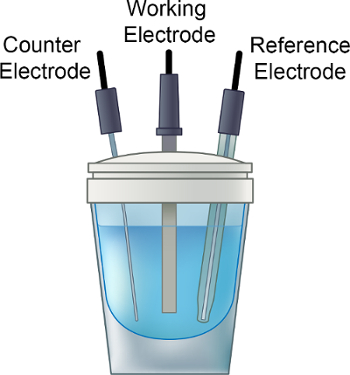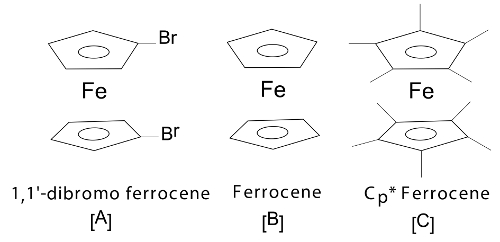循环伏安法 (CV)
Overview
资料来源: 实验室的博士凯拉绿色 — — 德克萨斯基督教大学
循环伏安法 (CV) 实验涉及一系列潜在电压测量时当前的扫描。在 CV 实验中,电极电势的沉管、 固定从预定的起始电位扫描到最终值 (称为开关潜在),得出反向扫描。这给 '循环' 扫的电位和电流与电位曲线所得的数据称为循环伏安图。第一次被称为 '向前扫描',回波被称为反向扫描。潜在的极端被称为 '扫描窗口'。氧化与还原电流的大小和形状的伏安是高度依赖分析物的浓度、 扫描速率和实验条件。通过改变这些因素,循环伏安法可以产生稳定的过渡金属氧化态中的电子转移反应的可逆性,复合体,资料及反应性的资料。这个视频会解释包括分析物制备和设置电化学电池的循环伏安法实验的基本设置。将提出一个简单的循环伏安法实验。
Principles
潜在的应用之间的参比电极和工作电极循环伏安法实验中增加以线性的方式与时间 (扫描速率 (V/s))。与此同时,当前被测量工作和计数器 (或辅助) 电极从而导致绘制为电流 (i) 的数据与潜力 (E) 之间。氧化与还原事件观察和分配中由此产生的情节。减少事件发生的分析物特定潜在电压在哪里反应 M+ n + e- → M+ n-1 (M = 金属) 是大力青睐 (称为还原电位) 和通过增加当前值来衡量。随着电压潜力达到减少潜在的被分析物,但然后脱落,达到最大的传质速率,当前将增加。当前下山只对其达到平衡在一些稳定的值。氧化反应 (M+ n → M+ n + 1 + e-),也可以作为当前在大力支持 electron(s) 的损失的电位值的减少而观测到。
然后分析了由此产生的伏安和注意到的潜力 (Ep) 和还原和氧化事件在每个安装程序的实验条件下的当前 (我p) 数据。此信息可用于评价可逆性的耦合的减少和氧化事件。如上文 (Epa和Epc) 的峰电位和峰值电流 (我pc和我pa) 是用来表征氧化还原情侣或事件的基本参数。在可逆的氧化还原过程中,一种化合物的氧化和减少形式是在电极表面的平衡。能斯特方程描述了潜力和平衡比率之间的关系 ([R] / [O])x = 0。
 (1)
(1)
在这里, 被称为正式的潜力的反应,并考虑到的活度系数和其他实验的因素。
被称为正式的潜力的反应,并考虑到的活度系数和其他实验的因素。
具体而言,通过给出峰值电流的可逆反应:
 (2)
(2)
在这里,我p是峰值电流的安培、 n是电子所涉及的数量, A是厘米2中电极的面积, Do是扩散常数 (厘米2/s), v是扫描速度 (V/s) 和Co*是体积浓度 (摩尔/厘米3)。扩散常数可以在其他地方用更广泛的实验详细说明测量和此视频1,重点不是。但是,更多的基本准则可用于评价系统1的可逆性。完全可逆系统1的标准:
 在各种扫描率n = 电子数
在各种扫描率n = 电子数 在不同的扫描率
在不同的扫描率- |我pa/我pc|= 1 在各种扫描率
- Ep是独立的v v = 扫描速率
- 在潜力超越Ep,我-2
 t
t
用于定义在 25 ° C 的完全不可逆系统的简单诊断测试方法:
- (这是指化学不可逆转,但不是一定对电子转移不可逆转) 没有反向峰值
- Epc转移
 为每十年增加v (电化学不可逆性)
为每十年增加v (电化学不可逆性) 
最后,用于定义一个准可逆系统的诊断测试方法:


- 消极地随v Epc转变
减少和/或氧化事件的位置可以用来推断有关过渡金属配合物的电子性质和对配体的影响作为捐助者的信息。例如,Fe+ 3 / + 2的二茂铁衍生物的还原电位是对由环戊二烯 (Cp) 配体集所提供的电子环境非常敏感。捐赠 (退出) Cp 取代基的电子增加 (或减少),电子密度对铁中心和氧化还原电位转向与 Fc (积极) 负值。
在本议定书中二茂铁将用作示例。实验条件,如溶剂、 电解液选择和研究潜在的范围内 (扫描窗口) 很大程度上取决于分析物溶解度和实验条件。用户被鼓励去咨询相关的文本,如吟游诗人与福克纳1以了解更多。
Procedure
1.电解质溶液的制备
- 准备股票电解液 (10 毫升) 组成的 0.1 M [埠4N] [高炉4] 在 CH3CN。
- 电解质溶液置于电化学瓶、 小搅拌棒,加到小瓶上盖,如图 1所示。
- 检查以确保氮铅在电解质溶液中。搅拌和脱气一连串温柔干 N2气 (~ 10 分钟) 要删除氧化还原活性分子氧的电解质溶液。
- 在步骤 1.3 中,小心地插入工作电极 (例如玻碳)、 计数器 (Pt) 和参比电极 (Ag/AgNO3) 铁氟龙单元格顶部。连接单元格站到适当的电极。

图 1。安装程序的一种电化学电池。
2.获取后台扫描
- 定义为溶剂的实验条件。对于乙腈,扫描窗口通常是衣料 mV — —-2,000 mV。
- 运行并保存伏安法的扫描速率 (例如 20 mV/s、 100 mV/s,和/或 300 mV/s) 范围内的电解质溶液。
- 检查生成的扫描,以确保在电解质溶液中有无杂质或剩余的氧气。一个干净的系统会有无氧化还原事件。如果安装程序污染,电极和玻璃器皿将需要清洗和电解质溶液重塑使用清洁组件。
3.分析物溶液的制备
- 结合分析物 (~ 2 5 毫米,终浓度) 与电解质溶液制备上述利益。
- 检查以确保氮铅在电解质溶液中。搅拌和脱气一连串温柔干 N2气 (~ 10 分钟) 要删除氧化还原活性分子氧的检测分析物电解液。
4.循环伏安法的被分析物
- 从 20 执行扫描速率的多个循环伏安法实验 mV — — 1,000 mV (取决于单元格站能力)。开始每次扫描使用计算潜在的开路。
- 有条不紊地改变扫描方向 [(+ to –) 和 (— — 到 +)] 和扫描窗口来隔离感兴趣的氧化还原事件。伏安法应该总是从零电流 (开路)。二茂铁 (Fc) 发生氧化反应向芳茂铁 (Fc+)。
- 很多团体规范数据到 Fc/Fc+氧化还原夫妇。在本练习中,~ 2 毫克的 Fc 添加到被分析物的解决方案,用于引用目的重复步骤 4.2。在数据分析中,所有的光谱被规范化为 Fc/Fc+夫妇设置为 0.00 V。归一化的还原电位表是可用2。
5.清洗电极和电化学电池
- 仔细地松开和删除每个电极的电化学电池。
- 冲洗用乙腈参比电极,用 Kimwipe 干。存储在参考电极的存储解决方案。
- 轻轻地清洁工作和反电极制造商的指导方针要求 (例如巴斯: http://www.basinc.com/mans/pguide.pdf) 来删除积累一些实验过程中的氧化还原反应产品。
Results
二茂铁在 300 mV/s 在乙腈中 CV 扫描进行和相应的伏安图如图 2所示。

ΔE可以来自基于Epa和Epc 机之间的区别的图 2中的数据。

循环伏安曲线叠加在图 3 中代表连续实验不同的扫描速率相同系统上执行。如上文所述的我p v1/2 (图 3中的插图) 与线性情节表明反应是扩散控制。
E1/2或氧化还原事件 (Epa或Epc) 的位置可以用于确定配体对氧化还原活性金属中心提供的电化学响应的影响。图 4显示了一系列基于二茂铁的同族体,其不同的替换的 Cp 环上。如图 5所示,吸电子基团卤化物结果E1/2值的这种复杂将被转移到更积极的潜能,因为氧化的形式稳定的吸电子基团配体。电子基团甲基化合物 C 结果在 E1/2的转向更负电位稳定氧化的物种。

图 2。二茂铁在 150 mV/s 在乙腈中 CV 扫描。请点击这里查看此图的大版本。

图 3。引出了一个减少事件的含钴的化合物。插图显示线性相关性我p 和 v1/2.请点击这里查看此图的大版本。

图 4。一系列基于二茂铁的化合物。请点击这里查看此图的大版本。

图 5。由此产生的循环伏安曲线的 A-C (图 4) 显示了明显的转变在E1/2 连接到金属中心电子配体效应。请点击这里查看此图的大版本。
References
- Bard, A. J., Faulkner, L. A. Electrochemical methods: Fundamentals and Applications. 2nd ed. New York: Wiley; 833 p. (2001).
- Geiger, W. E., Connelly, N. G. Chemical Redox Agents for Organometallic Chemistry. Chem Rev. 96 (2), 877-910, (1996).
Tags
跳至...
此集合中的视频:

Now Playing
循环伏安法 (CV)
Analytical Chemistry
125.2K Views

分析制备的样品制备
Analytical Chemistry
84.7K Views

内部标准
Analytical Chemistry
204.8K Views

标准加入的方法
Analytical Chemistry
320.1K Views

校准曲线
Analytical Chemistry
796.8K Views

(紫外-可见) 的紫外-可见光谱法
Analytical Chemistry
623.5K Views

拉曼光谱化学分析
Analytical Chemistry
51.2K Views

X 射线荧光光谱 (XRF)
Analytical Chemistry
25.4K Views

气相色谱 (GC) 与火焰电离检测
Analytical Chemistry
282.0K Views

高性能液相色谱法 (HPLC)
Analytical Chemistry
384.5K Views

离子交换色谱法
Analytical Chemistry
264.5K Views

毛细管电泳 (CE)
Analytical Chemistry
93.9K Views

质谱分析法导论
Analytical Chemistry
112.2K Views

扫描电子显微镜 (SEM)
Analytical Chemistry
87.2K Views

负载型催化剂,用恒电位仪/结合电化学测量
Analytical Chemistry
51.4K Views
版权所属 © 2025 MyJoVE 公司版权所有,本公司不涉及任何医疗业务和医疗服务。